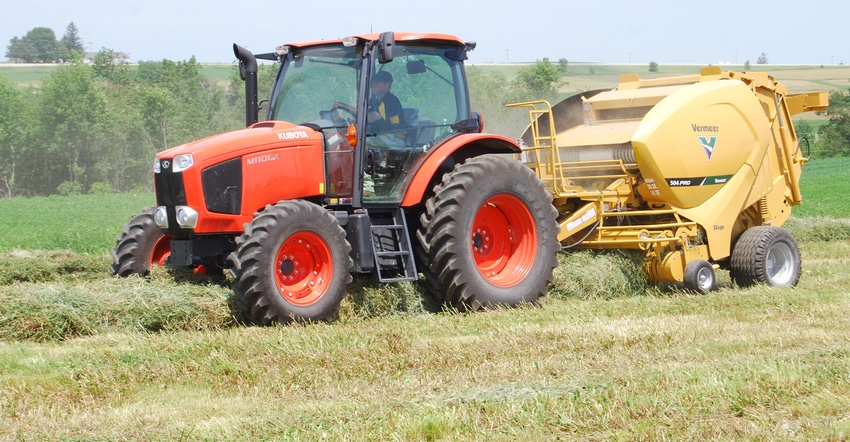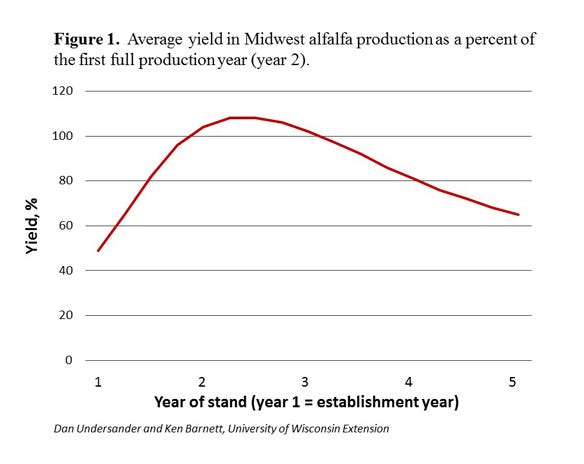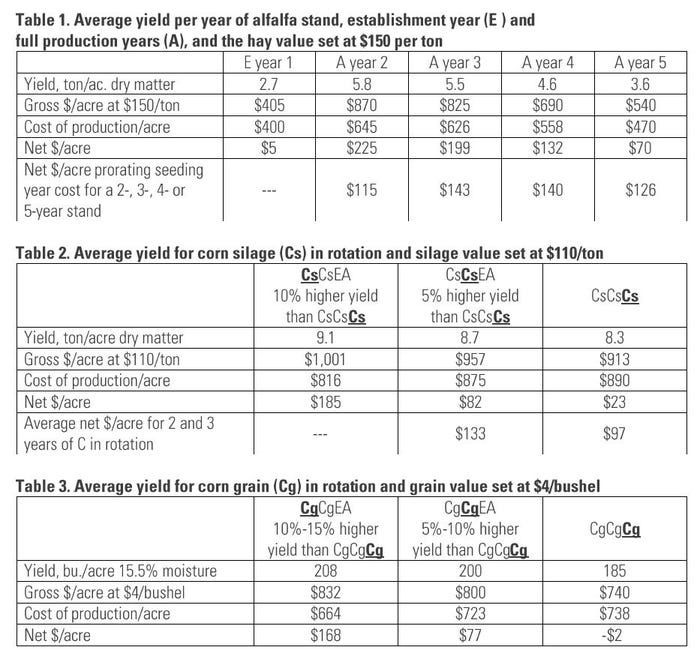September 13, 2018

A major economic challenge with alfalfa is the declining yield as the stand ages. Stands subjected over the years to various environmental stresses, wheel traffic damage and diseases tend to significantly decline in yield by the fourth or fifth year of production. The accompanying graph illustrates this. As alfalfa production starts to decline beyond the first two full production seasons (years two and three), an economic decision needs to be made as to when to rotate the field back to corn.
The graph shows the typical average yield decline of alfalfa in the Midwest with a 17% reduction in the third production year and 34% reduction in the fourth production year. These declines tend to be greater east of the Mississippi River and less west of the Missouri River.

Alfalfa yield decline with advancing age of the stand suggests farmers should rotate alfalfa stands after the third year to stay in a high yield range, or at least make the effort to evaluate the stands to help assess when it is time to rotate. You can do that by estimating the average number of stems per square foot in the stand. This assessment method is explained at University of Wisconsin Extension.
Compare value of rotations
Let’s take a closer look at the economics to compare the value of different alfalfa-corn rotations. We need to make a few assumptions. The yields in Tables 1 to 3 (at end of article) are from the USDA National Ag Statistics Service for Iowa, and we also incorporated yields from crop production trials at the ISU Northeast Research Farm. Since ISU Research Farm hay harvests are flail-chopped and weighed fresh, these yields were reduced by 20% to account for typical harvest losses.
Costs of crop production are based on ISU Extension publication A1-20, “Estimated Costs of Crop Production in Iowa — 2018.” However, A1-20 uses lower land values for alfalfa production than for corn, and since these rotations would be on the same land, we used similar land values for both crops.
In these rotations, the greatest economic savings is reduced costs in nitrogen fertilizer and corn rootworm control for corn following alfalfa. In addition, corn yields are higher in the year following alfalfa than with corn following corn. The greatest economic reduction for alfalfa is in the establishment year.
Economics of alfalfa production
To better compare the economics of one or more years of alfalfa production, Table 1 also provides establishment costs prorated across two, three, four and five years of alfalfa rotations. Taking this into account, it appears that the most economical rotations are EAACs and EAAACs followed by EAAACsCs and EAACsCs.
The underlined crops in tables 2 and 3 identify the crop being referred to in the given rotation sequence. For example, in Table 2 CsCsEA is first-year corn silage after alfalfa, and CsCsEA is second year corn silage after alfalfa. CsCsCs refers to continuous corn, or at least third-year corn in any given rotation.
A few years ago, the University of Minnesota ran a similar analysis on corn- silage-alfalfa rotation options. Alfalfa yield was reduced 0.46 tons of dry matter yield each subsequent year following the first year after establishment. Corn silage yield was 17% higher in the year following alfalfa than for corn after corn. They used the Agriculture Budget Calculation Software to calculate whole farm incomes and costs based on enterprise budgets.
4-year rotation most profitable
The six rotations compared were EAC, EAAC, EAACC, EAAACC, EAAAACC and EAAAACCC. The Minnesota researchers concluded that the four-year rotation of EAAC (establishment alfalfa year, then alfalfa, alfalfa, corn silage) was the most profitable. It was followed by the six- and seven-year rotations of EAAACC and EAAAACC. Least profitable were rotations of EAAAACCC and EAC.
No doubt actual numbers will vary on individual farms depending on their crop yields and costs of inputs, but the principles provided above would pertain to all farms. Alfalfa stand assessments of stems per square foot should be made most years, and at a minimum used to assess third- and fourth-year stands to help decide when to rotate the field out of alfalfa.

Lang is the Iowa State University field agronomist at Decorah in northeast Iowa. Contact him at [email protected].
About the Author(s)
You May Also Like






